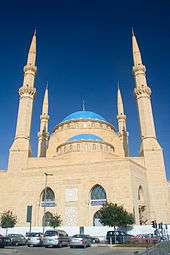Mohammad Al-Amin Mosque
Coordinates: 33°53′41.89″N 35°30′22.93″E / 33.8949694°N 35.5063694°E


The 'Mohammad Al-Amin Mosque, also referred to as the Blue Mosque, is a Sunni Muslim mosque located in downtown Beirut, Lebanon.
In the 19th century, a zawiya (prayer corner) was built on this site. Decades of preparation to obtain sufficient land adjacent to the old Zawiya led finally to the building of the new mosque. It was inaugurated in 2008.
Construction
Following a donation by late Prime Minister Rafik Hariri, the foundation stone for the Mohammad Al-Amin Mosque was laid in November 2002. The design is evocative of the Ottomans’ monumental architecture: with a built area covering approximately 11,000 square meters, a 48-meter-high blue dome and 65-meter-high minarets, the mosque has become a dominant feature of the Beirut City Center skyline. It was inaugurated in 2008.
Timeline
19th century: A Zawiya (prayer corner) was built on the site of what is today the Al-Amin Mosque, and named after Sheikh Abu Nasr Al-Yafi. 1950: Mohammad Al-Amin Association was created to replace the Zawiya with a mosque. 1975: Souk Abu Nasr and the Zawiya stop operating, following outbreak of the Lebanese Civil War. November 2002: Foundation stone of the new mosque was laid after a donation by late Prime Minister Rafik Hariri. 2008: Inauguration of the mosque.
History
In the 19th century, a Zawiya (prayer corner) named after Sheikh Abu Nasr al-Yafi was built on this site. Souk Abu Nasr was located in the same area and was operational, with the Zawiya, until 1975. Following earlier efforts by Beiruti families, the Mohammad Al-Amin Association was created in the 1950s in order to replace the Zawiya with a mosque, in the name of the Prophet Mohammad, and acquire more land. The project never materialized. It took decades of preparation to obtain sufficient land adjacent to the old Zawiya to build the new mosque. Following a donation by late Prime Minister Rafik Hariri, the foundation stone for the Mohammad Al-Amin Mosque was laid in November 2002. With its built area covering approximately 11,000 square meters, its 48-meter-high blue dome and 65-meter-high minarets, the mosque has become a dominant feature of the Beirut City Center skyline. Inaugurated in 2008, its design is evocative of the Ottomans’ monumental architecture. During the construction of the mosque on this corner of Martyrs’ Square, archaeologists uncovered a large section of the east-west main Roman street (Decumanus Maximus), with paving and columns.
See also
- Zawiya
- Sheikh Abu Nasr al-Yafi
- Souk Abu Nasr
- Mohammad al-Amin Association
- Rafik Hariri
- Martyrs' Square
- Cedars Revolution
- Decumanus Maximus
- Sunni Islam in Lebanon
References
- Vloeberghs, Ward (2008) “The Genesis of a Mosque: Negotiating Sacred Space in Downtown Beirut”, European University Institute Working Papers 17, Robert Shuman Center for Advanced Studies, Florence.
- Hallaq, Hassan (1987) Al-tarikh alijtima'i wa al-siyasi wa al-iqtisadi fi Bayrut, [Social, Political and Economic History of Beirut], Dar al-Jami'at, Beirut.
- Hallaq, Hassan (1987) Bayrut al-mahrousa fil'ahd al-'uthmâni, [Beirut during the Ottoman Period], Dar al-Jami'at Beirut.